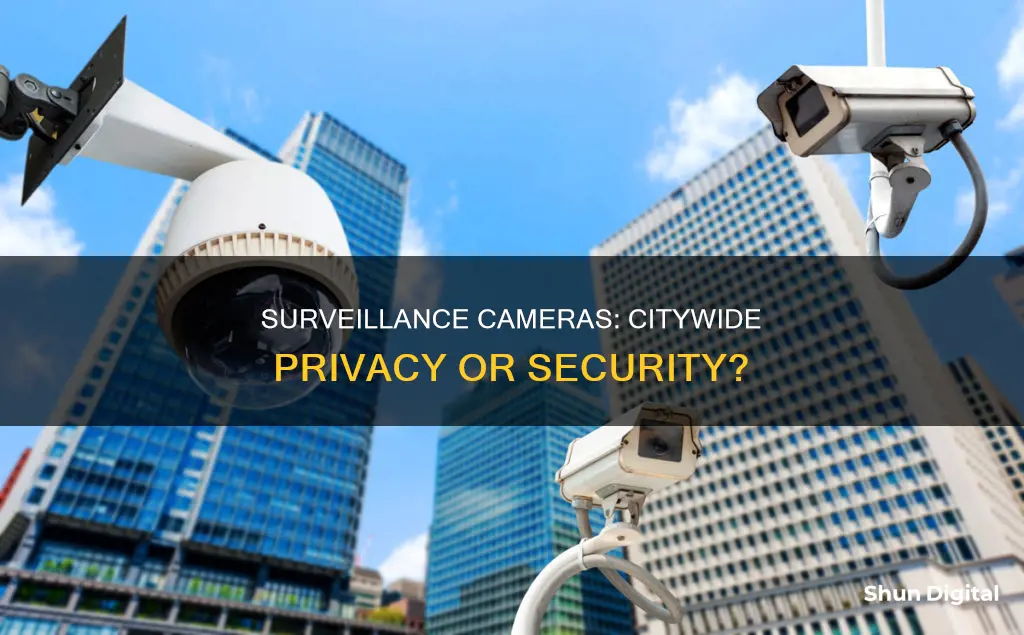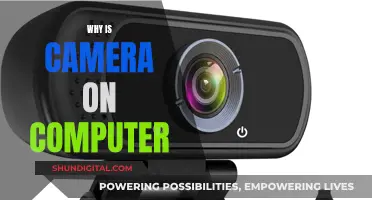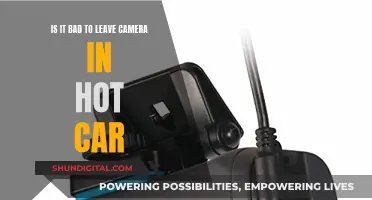
Citywide surveillance cameras are a contentious issue. Proponents argue that they improve public safety, help monitor community events and public gatherings, and aid law enforcement in investigating and prosecuting crimes. They are also believed to provide a sense of security and encourage civic participation. On the other hand, critics argue that they invade privacy, raise concerns about constant monitoring, and may not significantly reduce crime. The effectiveness of citywide surveillance cameras is a subject of ongoing debate, with some cities reporting a drop in crime rates, while others question the impact on crime prevention.
| Characteristics | Values |
|---|---|
| Crime reduction | Crime reduction is disputed. Some sources claim that surveillance cameras reduce crime rates, while others claim that they do not. |
| Crime resolution | Surveillance cameras can aid in the resolution of crimes by providing video evidence. |
| Community safety | Surveillance cameras can improve community safety and relations. |
| Business environment | Surveillance cameras can improve the local business environment by reducing crime rates and increasing foot traffic. |
| Public perception | The public perception of surveillance cameras varies, with some people feeling that they improve safety and others feeling that they invade privacy. |
| Privacy | Surveillance cameras can invade privacy, particularly when installed in residential areas. |
| Law enforcement | Surveillance cameras can aid law enforcement by providing real-time information and improving visibility across the city. |
| First responders | Surveillance cameras can assist first responders by providing information about incidents and helping to coordinate responses. |
| Public spaces | Surveillance cameras are typically installed in public spaces such as parks, sidewalks, and community events. |
| Technology | Surveillance camera technology includes features such as remote accessibility, proactive alerts, and multiple user access. |
What You'll Learn

Surveillance cameras can reduce crime rates
The effectiveness of surveillance cameras in reducing crime rates is a highly debated topic. While some argue that they are an invasion of privacy with little impact on crime reduction, others claim that they can significantly deter criminal activity.
One of the main arguments in favour of surveillance cameras is that they can make it easier for law enforcement to investigate and solve crimes. This was demonstrated in Orange County, New Jersey, where surveillance cameras led to a 50% drop in all types of crime. The cameras provided valuable footage that helped police officers apprehend and prosecute offenders. Additionally, in a study of 422 burglars, 60% stated that they would search for an alarm system and avoid houses with visible security measures in place.
However, the impact of surveillance cameras on crime rates is complex and multifaceted. Some studies have shown that while these cameras can reduce certain types of crimes, such as vehicle crimes in parking garages, they may not have a significant effect on violent crimes. For example, in Lincoln, Nebraska, cameras in a downtown bar street did not help identify criminals or prevent assaults, with 128 assaults occurring within 500 feet of the cameras.
Furthermore, the effectiveness of surveillance cameras is often dependent on their placement, the presence of additional security measures, and the ability to actively deter criminals. For instance, visible security cameras, combined with lighting and alarms, can make a house a less desirable target for burglars. On the other hand, hidden cameras may defeat the purpose of deterrence, as their primary benefit is in passively capturing criminal activity rather than actively preventing it.
In conclusion, while there is evidence that surveillance cameras can reduce crime rates in certain contexts, their effectiveness is not universally consistent. The placement, quality, and supplementary security measures all play a role in their success. Additionally, the ethical considerations of privacy and the potential for abuse must also be carefully weighed against the potential benefits of crime reduction.
Understanding Camera Raw: The 'A' Mystery Explained
You may want to see also

They can help identify and capture offenders
Citywide surveillance cameras are an effective tool for identifying and capturing offenders. They provide an objective and detailed account of incidents, aiding in quicker case resolutions and efficient resource utilisation. The footage captured by these cameras offers a clear and unfiltered view of events, making it difficult for judges and juries to dispute their authenticity.
In Denver, the installation of 135 cameras as part of the H.A.L.O. (High Activity Location Observation) system resulted in a 5% to 45% drop in crime. The system includes portable tactical cameras for SWAT and hostage negotiation situations, as well as integration with traffic and school cameras. The footage is recorded continuously and retained for 30 days, providing valuable evidence for investigations and prosecutions.
Surveillance cameras are particularly useful in identifying suspects and tracking their movements. With the help of facial recognition and license plate recognition technology, law enforcement can quickly locate and apprehend offenders. This was evident in the Boston Marathon bombing investigation, where suspects were identified through footage captured by the city's cameras.
Additionally, these camera systems can provide real-time notifications to law enforcement, allowing them to respond promptly to ongoing crimes. The community also benefits from increased safety, as these cameras deter crimes and make citizens feel more secure when attending public events.
However, it is important to consider privacy concerns and ensure that inappropriate views of private areas are avoided or masked. The successful utilisation of surveillance cameras relies on adequate resources, trained staff, and effective integration into law enforcement activities. While they provide valuable support, they should not be seen as a replacement for traditional police work and eyewitness testimonies.
Blocking Intersections: MD's Camera Ticket Price
You may want to see also

Cameras can be used to monitor public gatherings and activities
Citywide surveillance cameras are a contentious issue, with some people feeling safer with the presence of cameras, while others feel their privacy is being invaded. However, there are several ways in which cameras can be used to monitor public gatherings and activities.
Firstly, cameras enable law enforcement to monitor areas around community events and public gatherings proactively. This enhanced visibility provides peace of mind for citizens, making them more likely to attend and participate in community events. Cameras can also be used to monitor the security of public spaces and safeguard citizens from threats to their well-being. This is especially useful in day-to-day incident resolution, emergency response, and disaster management.
In addition, cameras can help resolve liability claims, criminal reports, and other incidents by providing objective video evidence. This assists in investigations and prosecutions, leading to quicker and more seamless incident resolution. Cameras can also be used to monitor traffic and enhance road safety.
Furthermore, the presence of cameras can act as a deterrent to crime. With the knowledge that their actions are being recorded, potential criminals may be less likely to commit a crime or engage in suspicious behaviour. This can lead to a decrease in crime rates and an increase in public safety.
Lastly, the footage from surveillance cameras can be used to improve community spaces. Local authorities can identify areas that need to be cleaned up or developed further, leading to an increase in community safety and cohesion.
New Camera Battery Died? Here's Why
You may want to see also

They are useful for incident resolution and emergency response
Citywide surveillance cameras are useful for incident resolution and emergency response. They help law enforcement resolve incidents more quickly and seamlessly. Cameras provide objective video evidence of incidents, which can be used to support investigations and prosecutions. This leads to a decrease in crime rates as more offenders are identified and charged. Additionally, surveillance footage can be used to resolve liability claims and criminal reports, providing a streamlined resolution process for citizens.
Surveillance technology also aids in emergency response and disaster management. For example, the H.A.L.O. (High Activity Location Observation) system in Denver, Colorado, has 135 cameras that record imagery continuously. This system not only helps fight crime but also assists in coordinating responses to natural or man-made disasters. The cameras provide real-time, high-resolution video, enabling law enforcement to dedicate resources to hotspot areas effectively.
Furthermore, advanced features such as real-time alerts and video analytics enhance the effectiveness of citywide surveillance systems. These features help detect threats, identify suspicious activities, and guide responses promptly. The integration of multiple systems, such as license plate recognition and traffic cameras, further improves the efficiency of emergency response and incident resolution.
While some may argue that surveillance cameras infringe on privacy, proponents emphasize that these cameras are installed in public spaces to protect and respond to crises and emergencies. They play a crucial role in improving public safety and sharpening crime protection measures. City officials and law enforcement can work together to address safety concerns, crime, and collaboration, ultimately delivering a better quality of life for citizens.
Storing Camera Batteries: Charged or Not?
You may want to see also

Surveillance can improve community spaces for citizens
Citywide surveillance cameras are a contentious issue, with some arguing that they are an invasion of privacy and a waste of taxpayer money, while others claim they are an effective tool for fighting crime and improving community safety. Those in favour of surveillance cameras argue that they can improve community spaces for citizens in several ways:
Crime Reduction and Prevention
Surveillance cameras are often touted as a powerful tool for crime reduction and prevention. Proponents argue that cameras can act as a deterrent, making citizens feel safer and discouraging potential criminals from carrying out illegal activities. In addition, cameras can aid in the identification and capture of offenders, leading to quicker investigations and prosecutions. This was the case in Denver, where the installation of 135 cameras led to a drop in crime of between 5% and 45%.
Community Development
The presence of surveillance cameras can also encourage the development of safer, cleaner, and more vibrant communities. By monitoring public areas like parks and sidewalks, local authorities can identify areas in need of improvement and take proactive measures to enhance neighbourhood safety. Additionally, the reduction in crime rates may attract more businesses to the area, positively impacting the economic health and employment rate of the community.
Incident Resolution
Surveillance cameras provide law enforcement with objective video evidence, reducing the reliance on witness testimonies. This enables police to resolve incidents more efficiently and quickly. Video footage can also serve as valuable evidence during trials, strengthening prosecutorial arguments and leading to more successful convictions.
Public Gathering Safety
Surveillance cameras can also improve the safety of public gatherings and community events. By monitoring these events, law enforcement can detect suspicious behaviours and respond in real-time to potential threats. Citizens may feel more comfortable attending such events, knowing that there is an added layer of security and protection.
While there are valid concerns about privacy and the potential for abuse, proponents of citywide surveillance cameras believe that the benefits outlined above can lead to significant improvements in community spaces and overall citizen safety. However, it is important to note that the effectiveness of these systems may vary depending on the specific implementation and the context in which they are deployed.
Viewing Raw Images: Overcoming Camera Crop Issues
You may want to see also
Frequently asked questions
While there is no nationwide data on the effectiveness of surveillance cameras, some sources claim that they are effective in reducing crime rates, while others claim that they are ineffective and invade people's privacy.
Citywide surveillance cameras can improve community safety, aid in incident resolution, and provide a sense of security for citizens. They can also help in monitoring public gatherings and activities, and provide valuable evidence for investigations and prosecutions.
Citywide surveillance cameras can be costly to implement and maintain. They may also raise privacy concerns, as they can capture footage of people's homes and residential areas. Additionally, there is a potential for abuse of power by those who control the cameras and their data.







